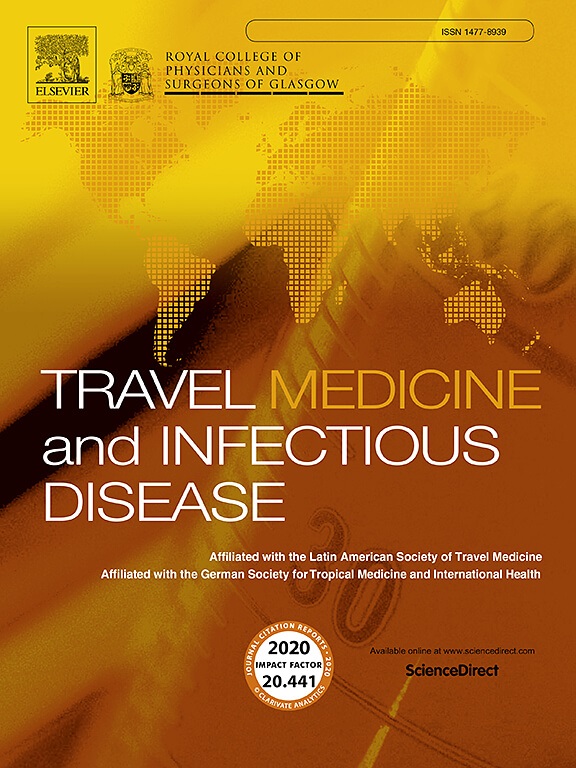A systematic review of contact tracing interventions for international arrivals by air, sea, or land
IF 4.7
3区 医学
Q1 INFECTIOUS DISEASES
引用次数: 0
Abstract
Introduction
As part of the public health response, one role of health protection specialists is to identify contacts of people who have travelled whilst infectious, and provide advice or other public health actions.
This paper aims to review the latest evidence for contact tracing of specific infectious diseases on incoming international travel by air, sea, or land. Twenty key gastrointestinal, respiratory, rash, and high consequence infectious diseases were included in this systematic review.
Methods
Electronic databases were systematically searched for studies published between 2008 and 2023, that focused on people arriving from international destinations with an infectious disease, and their contacts. Results were exported to Endnote; duplicates removed; eligible studies identified and critically appraised by two independent reviewers; and data extracted. Due to heterogeneity across studies, results were presented narratively.
Results
There was some evidence for contact tracing to reduce community transmission for international arrivals by aircrafts, but less rigorous evidence for those arriving by sea-vessels, and even less for ground crossings.
Conclusions
Informed by this systematic review, public health agencies should consider developing or reviewing their national disease-specific guidance, ensuring guidance for all key modes of international transport is included. Higher quality studies are required to inform the effectiveness of contact tracing for preventing further transmission related to international travel. Strategic efforts should continue to concentrate on improving the relationship between public health organisations and transport providers to facilitate timely public health actions.
对经空运、海运或陆路入境的国际接触者追踪干预措施进行系统回顾。
导言:作为公共卫生应对措施的一部分,卫生保护专家的作用之一是确定感染期间旅行过的人的接触者,并提供建议或采取其他公共卫生行动。本文旨在综述经海陆空入境人员中特定传染病接触者追踪的最新证据。本系统综述纳入了20种关键的胃肠道、呼吸道、皮疹和高后果传染病。方法:系统检索电子数据库,检索2008-2023年间发表的研究,这些研究的重点是来自国际目的地的传染性疾病患者及其接触者。结果导出到Endnote;重复删除;由两名独立审稿人确定并严格评价符合条件的研究;提取数据。由于研究的异质性,结果以叙述方式呈现。结果:有一些证据表明,通过接触者追踪可以减少飞机入境人员的社区传播,但对海船入境人员的接触者追踪证据不够严格,对地面过境人员的接触者追踪证据更少。结论:根据这一系统评价,公共卫生机构应考虑制定或审查其国家特定疾病指南,确保包括针对所有主要国际运输方式的指南。需要进行更高质量的研究,以了解接触者追踪在预防与国际旅行有关的进一步传播方面的有效性。战略努力应继续集中于改善公共卫生组织与运输供应商之间的关系,以促进及时采取公共卫生行动。
本文章由计算机程序翻译,如有差异,请以英文原文为准。
求助全文
约1分钟内获得全文
求助全文
来源期刊

Travel Medicine and Infectious Disease
PUBLIC, ENVIRONMENTAL & OCCUPATIONAL HEALTH-INFECTIOUS DISEASES
CiteScore
19.40
自引率
1.70%
发文量
211
审稿时长
49 days
期刊介绍:
Travel Medicine and Infectious Disease
Publication Scope:
Publishes original papers, reviews, and consensus papers
Primary theme: infectious disease in the context of travel medicine
Focus Areas:
Epidemiology and surveillance of travel-related illness
Prevention and treatment of travel-associated infections
Malaria prevention and treatment
Travellers' diarrhoea
Infections associated with mass gatherings
Migration-related infections
Vaccines and vaccine-preventable disease
Global policy/regulations for disease prevention and control
Practical clinical issues for travel and tropical medicine practitioners
Coverage:
Addresses areas of controversy and debate in travel medicine
Aims to inform guidelines and policy pertinent to travel medicine and the prevention of infectious disease
Publication Features:
Offers a fast peer-review process
Provides early online publication of accepted manuscripts
Aims to publish cutting-edge papers
 求助内容:
求助内容: 应助结果提醒方式:
应助结果提醒方式:


